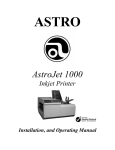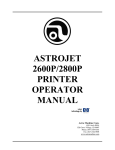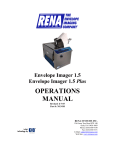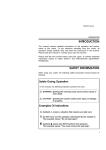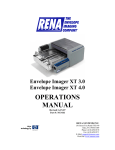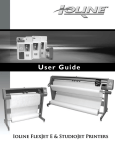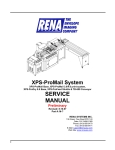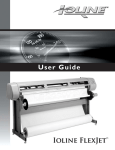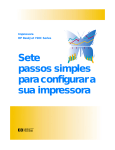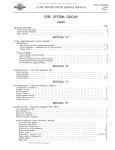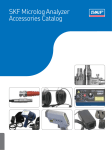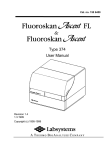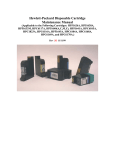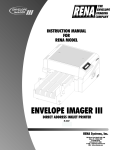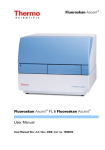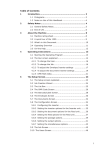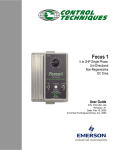Download SERVICE MANUAL - RENA Systems, Inc.
Transcript
Envelope Imager XT 3.0 Envelope Imager XT 4.0 SERVICE MANUAL Preliminary Revised: 6-4-07 Part #: M-6016 RENA SYSTEMS INC. 136 Green Tree Road STE 140 Oaks, PA 19456-1069 Phone: (610) 650-9170 Fax: (610) 650-9171 E-Mail: [email protected] Web Site: www.renausa.com SAFETY PRECAUTIONS THIS EQUIPMENT PRESENTS NO PROBLEM WHEN USED PROPERLY. HOWEVER, CERTAIN SAFETY RULES SHOULD BE OBSERVED WHEN OPERATING THE PRINTER. BEFORE USING THE PRINTER, YOU SHOULD READ THIS MANUAL CAREFULLY AND FOLLOW THE RECOMMENDED PROCEDURES, SAFETY WARNINGS, AND INSTRUCTIONS: 9 Keep hands, hair, and clothing clear of rollers and other moving parts. 9 Avoid touching moving parts or materials while the machine is in use. Before clearing a jam, be sure machine mechanisms come to a stop. 9 Always turn off the machine before making adjustments, cleaning the machine, or performing any maintenance covered in this manual. 9 Use the power cord supplied with the machine and plug it into a properly grounded wall outlet located near the machine and easily accessible. Failure to properly ground the machine can result in sever personal injury and/or fire. 9 The power cord and wall plug is the primary means of disconnecting the machine for the power supply. 9 DO NOT use an adapter plug on the line cord or wall outlet. 9 DO NOT remove the ground pin from the line cord. 9 DO NOT route the power cord over sharp edges or trapped between furniture. 9 Avoid using wall outlets that are controlled by wall switches, or shared with other equipment. 9 Make sure there is no strain on the power cord caused by jamming between the equipment, walls or furniture. 9 DO NOT remove covers. Covers enclose hazardous parts that should only be accessed by a qualified service representative. Report any damage of covers to your service representative. 9 This machine requires periodic maintenance. Contact your authorized service representative for required service schedules. 9 To prevent overheating, do not cover the vent openings. 9 Use this equipment only for its intended purpose. In addition, follow any specific occupational safety and health standards for your workplace or area. This manual is intended solely for the use and information of Rena Systems Inc., its designated agents, customers, and their employees. The information in this guide was obtained from several different sources that are deemed reliable by all industry standards. To the best of our knowledge, that information is accurate in all respects. However, neither Rena Systems Inc. nor any of its agents or employees shall be responsible for any inaccuracies contained herein. The Envelope Imaging Company TM is a registered trademark of Rena Systems Inc. Hewlett-Packard is a registered trademark of Hewlett-Packard Corporation. Windows 95 and Windows 98 are registered trademarks of Microsoft Corporation. IBM is a registered trademark of International Business Machines. All other trademarks are the property of their respective holders. All rights reserved. No part of this book may be reproduced or transmitted in any form or by any means, electronic or mechanical, including photocopying, recording, or any information storage and retrieval system, without permission in writing from the publisher TABLE OF CONTENTS Table of Contents SECTION 1 – Installation Unpacking the Printer Choose a Location Connecting the Printer and Optional Feeder Installing the Optional FF14 Friction Feeder Installing the Ink Cartridges Adjusting the Printer to the Media Installing the Printer Driver Installing the BIOS Manager SECTION 2 – Trouble Shooting 1 1 1 1 2 3 4 6 7 9 Power Problems Interface Communication Problems LCD Display Problems Feeding Problems Printing Problems Print Placement Problems Print Content Incorrect Software Problems Service Diagnostic Tests 9 9 9 10 11 12 13 13 13 SECTION 3 – Functional Operation 15 Sequence of Operation Printer Control Panel Printer Driver Properties Printing from Microsoft Word Printing from DeskTop Mailer Print Recovery after Jam SECTION 4 – Adjustments Carriage Assembly Timing Adjustment Drive Belt Tension Adjustment Output Voltage Adjustment Media Sensor Adjustment Print Speed Adjustment FF14 Friction Feeder Speed Control Adjustment FF14 Friction Feeder Sensor Adjustment SECTION 5 – Disassembly and Assembly Tools Required Basic Disassembly Removing the Print Cartridge Service Disassembly Procedures Side Covers Removing Printhead Assemblies 15 16 18 22 23 26 27 28 29 30 31 32 33 34 35 35 35 36 36 36 39 i TABLE OF CONTENTS Replacing Drive Belts and Driver Motor Replacing Conveyor Belts Replacing the Printhead Transport Belts Replacing the Sheet Separators on Optional Feeder Replacing the Feed Rollers in the Optional Feeder SECTION 6 – Maintenance The Inkjet Cartridge Cleaning Appendices Appendix A – Envelope Imager XT 3.0/XT 4.0 Specifications Appendix B – Supplies and Optional Hardware Appendix C – Wiring Diagram ii 40 40 43 44 45 47 47 49 51 51 52 53 SECTION 1 INSTALLATION Section 1 – Installing the Printer To install the printer the following must be done: • Choose a location for the Printer and optional feeder • Place the feeder and connect it to the printer • Plug in the printer and feeder, then connect the printer to the computer • Install the Inkjet Cartridges • Set up the feed on the feeder • Install the Printer software on the computer • Create a job to be printed (refer to Section 3 – Operating the Printer) Unpacking Printer Remove the packing blocks from between the printheads. Choose a Location The Printer with the feeder should be placed on a sturdy worktable or cabinet at least 12 inches from any walls. Allow enough room to place the Feeder on the same work surface. Protect the Printer from excessive heat, dust, and moisture – avoid placing it in direct sunlight. Place the printer on the support stand if supplied. (The stand is supplied only when the optional FF14 Friction Feeder is used. Connecting the Printer and Optional Feeder Plugging in the Printer Make sure that the main power switch of the Printer is in the OFF position. 1. 2. Connect one end of the power cord to the rear of the Printer in the corresponding receptacle. Plug the other end into a 115-220 Volt AC, 50/60 Hz. Grounded outlet. CAUTION Do not use an adapter plug or extension cord to connect the printer to the wall receptacle. Do not use outlets controlled by wall switches. 1 SECTION 1 INSTALLATION Do not use an outlet that shares the same circuit with large electrical machines or appliances. Connecting to the Computer Plug the parallel printer cable from your computer into the rear of the printer and latch the two locking clips. If you are using a USB connection, then connect the USB cable as shown. Parallel Connection Installing the Optional FF14 Friction Feeder Assembling the Feeder After unpacking the feeder install the two side guides as shown using the four screws supplied (two on each side) Place the feeder on a flat level surface. The feeder can be permanently mounted by removing the four rubber feet, aligning the feeder on the support stand, then reinstalling the feet to hold the feeder in place. Plugging in the Feeder Make sure that the main power switches of the Printer and the Feeder are in the OFF position. 1. 2. Connect one end of the power cord to the rear of the Feeder in the corresponding receptacle. Plug the other end into a 115-220 Volt AC, 50/60 Hz. Grounded outlet. CAUTION DO NOT USE AN ADAPTER PLUG OR EXTENSION CORD TO CONNECT THE PRINTER TO THE WALL RECEPTACLE. DO NOT USE OUTLETS CONTROLLED BY WALL SWITCHES. DO NOT USE AN OUTLET THAT SHARES THE SAME CIRCUIT WITH LARGE ELECTRICAL MACHINES OR APPLIANCES. 2 USB Connection SECTION 1 INSTALLATION Connecting the Optional Feeder to the Printer The Printer/Feeder Communication Cable must be attached to the printer and the feeder for the two machines to work together. Attach the Printer/Feeder Communication Cable between the two machines as shown in the photos. The cable is connected to the interface plugs as shown Printer Interface Feeder Interface Install the Inkjet Cartridges Standard Cartridge Installation The Envelope Imager XT 3.0/XT 4.0 can be configured with 6 or 8 inkjet cartridges depending on model. The standard cartridges are installed as follows: 1. Remove the inkjet cartridge from its packaging, taking care not to touch the copper contacts, the metal plate, or the gold printhead. Remove the protective tape from the printhead. 2. The cartridges are held in place by a latch lever mounted on the inkjet cartridge holder. Release the lever by raising it vertical. 3. With the cartridge’s printhead pointing down, slide the cartridge into the holder and push down and toward the contacts in the holder. 4. Make sure the cartridge is seated in the holder then close the latch lever to secure the cartridge in the holder. Do not force the lever into place. (See the diagram.) 5. Repeat the above for the remaining cartridges. NOTE: For optimum image quality during the run, refer to "Cleaning the Printhead" on page 39. The ink in the cartridge may be harmful if swallowed. Keep new and used cartridges out of reach of children. Discard empty cartridges immediately. 3 SECTION 1 INSTALLATION Adjusting the Printer to the Media Place one piece of media on the center of the conveyor portion of the feeder and adjust the side guides [1] to the media. Use one or two center straps [2] to help hold the media down. The center belt has a vacuum assist feature that can be turned on with the Vacuum Transport Switch located above the motor circuit breaker as required. It is useful in feeding smaller size stock. NOTE: The two narrow belts can be moved by turning the printer ON and sliding the belt guide adjusters located under the conveyor table in the appropriate direction until they are under the media. Optional Feeder Setup and Operation 1. 4 Release the separator locking lever and raise the separators to their up position as shown. SECTION 1 INSTALLATION 2. Place the media under the separators and release them so that they rest on the media. Then lock the separators in position using the separator-locking lever. 3. Adjust the side guides to within 1/32” of the media. Then adjust the rear guide so that the media is raised approximately 1/2”. (For heavy thick media this may not be required.) 4. Adjust the exit roller pressure by pushing in on the pressure control lock button [A] and raising or lowering the adjusting lever [B]. For plain paper or envelopes the lever should be in the down position, for thicker material the lever should be adjusted so that the media is fed without any bounce in the exit roller assembly. 5. Turn on the feeder and feed one piece with the speed control set to low speed (1 or 2). Stop the feeder with the piece half way through the exit. Then adjust the feed sensor so that it is pointed directly at the piece as it exits the feeder. The sensor prevents double feeding in case of a jam or stoppage. 6. Turn the feeder power switch ON. Set the AUTO/MANUAL switch to AUTO and press the CONTINUOUS feed button for continuous feeding. 5 SECTION 1 INSTALLATION 7. Turn the Printer on and then turn the media thickness knob to set the initial print head height as follows: NOTE: These are initial settings. It may be Media Thickness Dial Setting necessary to adjust the MEDIA .004” to 1/32” 0 to 2 THICKNESS control to optimize the print quality 1/32” to 1/16” 2 to 3 8. To test feed media after setup turn on the feeder and the printer. Place the AUTO/MANUAL selector switch on the feeder to the AUTO position. Press the ON-LINE key on the printer, and then press the ENTER key, to test feed media. 1/16” to 1/8” 1/8” to 1/4” 1/4” to 3/8” 3 to 5 5 to 7 7 to 10 Installing the Printer Driver A dedicated printer driver is included with the Printer. It is installed on your computer and is used by your applications whenever you are printing from the Printer. Follow the steps below to install the driver: NOTE: The driver for the Printer should be installed using the steps below. It is not installed as a standard windows driver. 1. If you have, any applications running on your computer close them and restart the computer before beginning the driver installation. 2. Install the CD in the CD drive and click on START. Then click on RUN, then type the following; D:\Setup.exe (where D is the CD drive) then click OK. 3. The “Add Printer Wizard (n.nn)” window will open, click Next>. 4. Type in your Name and Company and click Next>. 5. Select the printer port LPT1: Then click Next>. The “Add Printer Wizard” will appear. Select Envelope Imager XT 3.0/XT 4.0, and then click Next>. NOTE: Each printer has a specific driver. 6 Printer Model Envelope Imager XT 3.0 (Left to Right operation) Printer Driver Envelope Imager XT 3.0 Envelope Imager XT 4.0 (Left to Right operation) Envelope Imager XT 4.0 6. The next screen allows you to “Name Your Printer”. Unless you have another printer of the same name on your system or network ignore this step and click Next>. 7. Click Finish to complete the installation. SECTION 1 INSTALLATION Installing the BIOS Manager The BIOS Manager is used to upgrade the BIOS in the printer. To Install the BIOS manager on your computer do the following: 1. If you have, any applications running on your computer close them and restart the computer before beginning the BIOS manager installation. 2. Install the CD in the CD drive and click on START. Then click on RUN, then type the following; D:\SetupPCLPrinterUitilities.exe (where D is the CD drive) then click OK. 3. Follow the directions on the screen to install the BIOS manager software. Using the BIOS manager From time to time, you may receive new BIOS for the printer. When the new BIOS is received, it will have to be loaded in the flash ROM on the printer. This is where the BIOS manager comes in. First, you will receive the new BIOS either via e-mail or on a floppy disk. It will have to be loaded into the BIOS manager software. 1. Open Windows Explorer and click on Program Files, then PCL Only Printer Utilities. Save the BIOS file to this folder. 2. Connect the Printer to the computer using the Parallel Port and turn the Printer ON. 3. Then in Start click on Programs, then the “PCL Only Printer Utilities” program and then click on “PCL Only BIOS Manager.exe” to start the program. 4. The BIOS Manager window will open. Click on the Open button, and select the new BIOS from the list of BIOS. Then click Open. This will return you to the BIOS Manager. Check to see that the green Line light is lit and then click on Install and the program will install the new BIOS on the printer. 5. The BIOS manager will install the new BIOS. When the downloading is completed click on Exit to exit the program. WARNING DO NOT TURN OFF OR DISCONNECT THE PRINTER DURING THE DOWNLOAD PROCESS. DOING SO WILL DAMAGE THE MAIN PROCESSOR PC BOARD. 7 SECTION 1 INSTALLATION Notes 8 SECTION 2 TROUBLE SHOOTING Section 2 – Trouble Shooting This section is arranged by first the condition that might occur, and then by possible problems, their cause and recommended solutions. Power Problems CONDITION PROBLEM SOLUTION Power is on, nothing happens. No power to printer Check that the power cord is plugged in. Check that the power outlet is live. Check the fuse in the main power switch. Replace with a fuse of the same rating. Check the fuses on the power supply PC Board. (Requires disassembly) Bad controller PC Board. Bad power supply. Interface Communication Problems CONDITION PROBLEM SOLUTION Printer does not respond to software. Connection problems. Printer not responding to software Poor connection between printer and computer Check, that port is communicating with printer by using another parallel or USB cable, replace cable. If port cannot communicate using another parallel or USB cable, check printer. If port cannot communicate using another parallel or USB cable and the printer is OK, check parallel or USB port. Check cable connection to see if any of the pins are bent or missing. If so replace cable. Turn printer off and on again. Check connections. PROBLEM SOLUTION LCD Display Problems CONDITION No LCD display Power not on Contrast pot broken or maladjusted Broken solder joint on contrast pot Turn power switch on. If still no display see Power Problems Adjust pot or replace display PC Board. Repair or replace the display PC Board. 9 SECTION 2 TROUBLE SHOOTING CONDITION PROBLEM LCD shows solid line of characters or garbage. Power supply. LCD displays solid black line or lines Static electricity Bad power supply No firmware (BIOS) Bad processor PC Board SOLUTION Check voltages and inspect the power supply connections to the processor PC Board. Turn printer off and then on. Check all voltages Install firmware Replace processor PC Board Feeding Problems CONDITION Intermittent feeding PROBLEM Feed ramp not used Side guides set improperly Dirty feed rollers Paper stuck together Bad or dirty sensor Multiple feeds Failure to feed Uneven mail piece Separator gap not set properly. Sensor bad or dirty Media stuck together. Side guides too close to media Brake misadjusted. Side guides too close to media ENTER key not pressed. No power to printer. Feed gap too tight. Feed gap too loose Material is out of specification. Motor on, feed rollers not turning. Clutch not engaging. Motor failure. No power Printhead adjustment too low. Jams Paper path obstruction Paper not loaded properly Feed ramp not used properly Separators improperly adjusted Media curled or bent. Bad or Dirty Sensor 10 SOLUTION The feed ramp adds a slope to the stack and helps feeding. Loosen the side guides slightly. Clean the feed roller with distilled water and a cloth. DO NOT use any solvents or detergents as they may damage the feed rollers. Fan media before placing it in printer Clean sensor with compressed air or replace it. Tap inserts to front of envelopes and retry. Adjust separators to thickness of media. Clean sensor with compressed air or replace it. Fan media before feeding. Push side guides away from media. Adjust brake (see Section 4- Adjustments) Readjust side guides Instruct user on proper operation. Check the power button is ON and that the power cord is plugged in. Adjust separator to thickness of media Adjust separator to thickness of media. Maximum thickness is 3/8” or 0.375” Press the ENTER key, check for broken drive belt and replace, check for loose set screws on drive pulley or belt drive roller pulley. Replace Clutch. Check motor circuit breaker or replace motor. See Power Problems in this Section. Adjust printhead height to accommodate the media thickness. Clear jam and remove pieces remaining under printhead. Instruct operator in proper loading of media. Set feed ramp Adjust separators to thickness of media. Uncurl media. Clean or replace sensor. SECTION 2 TROUBLE SHOOTING CONDITION Jams continued PROBLEM Worn separator tip. Printhead adjusted too low. Conveyor tape(s) under printhead broken. SOLUTION Replace separator tip. Raise printhead Replace tapes. Printing Problems CONDITION PROBLEM No printing: Media is blank after going under printheads. Sensor did not see the piece and send the signal to print to the PC Board. Clogged cartridges Cartridge dried out Tape on printhead Cartridge not properly inserted Cartridge empty Power supply voltage out of spec. Printhead holder Printhead not positioned correctly to print on media Skew within specs. Print slanted or skewed Line spacing not uniform Gray print Blurry print CONDITION Side guides not set properly Printheads adjusted too high Printheads not aligned properly Ink cartridge almost dry Envelope thickness adjustment incorrect Dirty printheads Paper too porous or absorbent Printheads scratched when cleaned PROBLEM Blurry printing continued Printhead assembly not synchronized Printing light Printhead clogged or dirty Resolution of output set too low Running low on ink Envelope thickness set too low Exit roller dirty Printhead dirty Check voltage from power supply Poor printhead connections Print streaking Non-uniform print quality SOLUTION Clean or replace the sensor as required. Clean and purge cartridges Install new cartridge Remove tape Remove and reinsert cartridge Install new ink cartridge Check voltages Check flex circuit for tears Adjust printhead to print on media ± 2.5° from bottom edge of material Readjust Reset or lower printheads Realign printheads Replace ink cartridge Adjust media thickness knob to lower printhead Clean printheads Use other paper Replace printhead SOLUTION Adjust the carriage assembly timing to ensure that the cartridge assembly powers smoothly and contacts the media evenly on all corners Purge and clean printheads Reset to a higher resolution Replace cartridge Adjust media thickness Clean exit roller with water Clean printhead Adjust to 14 VDC Check that the flex circuit connections are in place 11 SECTION 2 TROUBLE SHOOTING CONDITION White lines/streaks in a line of print Smeared ink PROBLEM Ink cartridge nozzle dirty Cartridge not properly inserted Cartridge was hit, shaken, or dropped Tap water was used to clean cartridge and mineral deposits have blocked the ink chamber Wrongly directed or forceful wiping have driven particles into nozzles Cartridge low on ink Tape covering print nozzle or vent holes Printhead connections not set Bad printhead drive card Carriage too low Coated paper preventing ink absorption High humidity slowing drying time SOLUTION Clean cartridge Remove and reinsert cartridge Replace Cartridge Replace cartridge Replace cartridge, Instruct operator in proper cleaning method Replace cartridge Remove tape Check that flex circuit connections are in place Replace printhead drive card Raise Carriage Use fast-dry ink and/or allow more time to dry after printing Use fast-dry ink and/or lower dpi resolution Print Placement Problems CONDITION 12 PROBLEM SOLUTION Print too close to leading or trailing edge of media Size of media not set correctly in Layout Bad or dirty sensor Feed ramp not used properly Printheads set incorrectly Print too high or low on the media Physical location of printhead does not match the layout template Address prints upside down on media Layout and/or stock direction incorrect Check layout in layout for proper size Clean or replace sensor Set feed ramp Check the location and margins in layout software. Check that the piece on the layout screen looks exactly the way you want the piece to look. Remember that there is a 1 5/16” space that is always blank between Head 4 and 5 and the Head 1, 2, and 3 bank Adjust the paper guides or printheads. Use the “0” reference point in the center of the scale to help you align the print on the media Change direction from Normal to Inverted or Inverted to Normal in the Properties of the Driver. SECTION 2 TROUBLE SHOOTING CONDITION Address too close to center of media Address printing partially off media PROBLEM Chosen media size in layout is too small The physical location of the printheads do not match the layout Feed ramp not set properly Chosen media size in layout is too large The physical location of the printheads do not match the layout Feed ramp not set properly SOLUTION Set correct media width size in layout Check image on layout screen, Adjust paper guide or printhead Adjust feed ramp Set correct size from in layout Check image on layout screen, Adjust paper guide or printhead Adjust feed ramp Print Content Incorrect CONDITION Information being printed is wrong, incomplete, or garbage Barcode does not print PROBLEM Poor cable connections Interface problem Corrupted database file Wrong font selected No zip code in database Barcode not enabled Unwanted BOLD, Italic, or Underlined type Not all addresses in database print Data is being lost Graphics or text have a white line through them Turned on in layout Only some of the addresses in database have been selected to print Database problem Parallel or USB cable connection loose The graphic or text is set between the junction of two printheads SOLUTION Check parallel cable: Securely fastened at both ends Cable does not exceed 6’ in length Printers internal parallel or USB cable in good condition Check printer setup at computer Use another database file If using a combined field barcode choose USPS barcode font Put zip code field in database or use another database Enable barcode Open layout and change type style Start new job and select entire database Check the database program Reconnect Move the copy or adjusts the printhead Software Problems Refer to the manual for the application software being used. Service Diagnostic Tests TEST PRINT key Press the TEST PRINT key to place the printer into the Test Printing mode. Press the ENTER key to print a test sheet. NOTE: Remove all media from the printer before performing these tests. 13 SECTION 2 TROUBLE SHOOTING To access the Test Print mode press and hold the TEST PRINT key until “Service Menu” is displayed on the printer control panel. You can use the + or – key to step through the test options. Drive Speed Test Press the ENTER key to start the main drive motor and display the belt speed in inches per second. Press the ENTER key to stop the main drive motor. If the main drive motor does not start, the main drive motor circuitry has a problem. No reading in inches per second indicates an encoder problem. Motor Test Press the ENTER key to start the main drive motor. Press the ENTER key to stop the main drive motor. The main drive motor not starting indicates a problem in the main drive motor circuitry. Clutch Test 1 Press the ENTER key to start the main drive motor and turn on the feed clutch. Press the ENTER key to turn off the feed clutch. If the clutch does not engage there is a problem with the clutch circuitry. Clutch Test 2 This test is designed to operate the clutch in an ON and OFF mode. Selecting this test and pressing ENTER will cause the clutch to actuate and de-actuate in sequence. Sensor Test Press the ENTER key to display the state of the paper sensor. Uncovered displays when the sensor is NOT covered. Covered displays when the sensor IS covered. Use a strip of paper inserted in the sensor area to test its function. Failure to switch between the two messages indicates a problem in the sensor circuitry. Power Supply Test Press the ENTER key to display the voltage reading of the main power supply. The nominal reading is between 13.5 and 14.5 volts. The power supply may need adjusting to bring the value within the nominal range. Encoder Test Press the ENTER key to display the current encoder count reading. Move the exit roller. If the number does not increase, this indicates an encoder failure. Keyboard Test Press the ENTER key to test the function of the individual keys on the keyboard. When a key is pressed, the display shows the key name. To exit this test you must power the printer OFF. Head Lift Test Turn the MEDIA THICKNESS knob to “0”. Then press the ENTER key to lower the printhead carriage assembly. DOWN displays. Press the ENTER key to raise the printhead carriage assembly. UP displays. Failure of the carriage to move up and down indicates a failure in the head lift circuitry or with the media thickness control. Ink Levels The Ink Levels in each of the cartridges are displayed in this mode as a percentage. This will only display properly if the operator resets the system when a new cartridge is installed. A global reset of the Ink Levels can be accomplished by holding the MENU key down while turning on the printer. The display will then say “Resetting all ink levels in flash”. Releasing the MENU key will return the printer to normal operation. 14 SECTION 3 FUNCTIONAL OPERATION Section 3 – Functional Operation Sequence of Operation The user prepares the printer 1. Selects number and color of print cartridges required and installs cartridges in proper location. 2. Uses a single piece of media to set sheet separators. 3. Loads media and adjusts side guides to within 1/32” of media. 4. Stacks media in feeder and adjusts feed ramp. 5. User adjusts Media Thickness knob for proper printhead contact with media. 6. Turns printer on. The user prepares the layout and creates a job 1. The user selects the database and opens the layout software such as FlexMail or Microsoft Word. 2. Creates a layout consisting of the variable data from the database using the merge function. 3. User then creates a layout using fixed information such as return address and adds graphics as required. 4. User saves layouts. 5. User initiates the Print function through the File menu in the program. 6. User then selects through the printer driver properties menu if the job has and overlay or not. 7. User then clicks on the print button to print the job. Printing the Job. 1. When the user sends the job to the printer and downloading is complete, the system sends a signal to the interface board to turn on the main motor with the predetermined speed selected in the printer driver or by the operator in the printer properties dialogue box. 2. This causes the ON LINE light to illuminate on the ON LINE key and the drive motor starts to run causing the media transport belts under the printheads to turn. 3. The printhead carriage is lowered by the servomotor to the preset adjustment, which is controlled by the Media Thickness knob. 4. The user then presses the ENTER key and the feed clutch on the optional feeder turns causing the three sets of feed rollers to turn and feed the media. 5. After the media travels to a point just before the printhead carriage it reflects in the photo sensor and makes it turn on the printheads. The forwarding rollers that are driven by the transport belts move the media forward to the printheads. The gap between the mailing pieces is controlled by the speed of the optional feeder. This gap can be varied and allows the media to feed reliably and the variable data sent by the PC to be positioned for printing. 15 SECTION 3 FUNCTIONAL OPERATION Printing The print engine consists of six or eight stationary printheads depending on the model and moving transport belts, which position the media. Four circuit boards control the printer. (See the end of this chapter for their description and location. Printer Functional Description 1. A photo sensor in the path of the media just before the printing section senses the lead edge of the media and sends a signal to the print engine on the main processor board that the mailing piece has arrived for printing. 2. When the mailing piece uncovers the sensor the print engine downloads the next variable record from the PC and gets ready for printing of next piece. 3. This cycle repeats itself as long as there is media in the feeder. 4. The cycle stops when the feeder runs out of media, the operator stops the process, or there are no records remain to be printed. Printer Control Panel Control Panel 1. 2. 3. 4. 5. 6. 7. 8. 9. 10. MEDIA THICKNESS – The knob on the right side of the control panel is used to adjust the height of the print heads to compensate for different media thickness. ON LINE key – The indicator on lights when data is sent to the and they are ready to begin printing. This key also turns the printer off line so that the menu mode can be accessed. FAULT Indicator – This indicator lights when there is a problem with the printing process. - key – In the menu mode this key will scroll to the previous selection. + key – When the printer is in the menu mode this key will scroll to the next selection. ENTER key – This key starts and stops the printing. MENU key – This key causes the printer to enter the menu mode where several operator functions can be accessed. OPERATOR DISPLAY – Indicates the printer’s status including menus and error messages. RESET key – This key will reset the printer to its wait state. TEST PRINT key – Pressing this key will put the printer in the test mode and send a sample copy to check the printer’s output. Printer Control Panel When you first turn the printer ON, the light in the TEST PRINT key lights and the display becomes active. At this point, the printer is ready to print if it is connected to your computer. The printer control panel keys can be used to access various functions that help the operator control the printer. These functions and their operation are as follows: 16 SECTION 3 FUNCTIONAL OPERATION ENTER key The ENTER key is used to start the printer printing under production situations. When the printer is placed in any of the menu modes, the ENTER key is used to choose the options available. TEST PRINT key Pressing the TEST PRINT key momentarily places the printer in the test print mode. The word “Working “appears in the lower half of the display and after a short period of time the display changes to “Enter to feed”. Pressing the ENTER key will start the printing process and print the test print. To stop the feeding press, ENTER again. To restore the printer to the normal ready mode press the ON LINE key to take the printer off line and then press and hold the RESET key until the light on the TEST PRINT key blinks. The printer is then restored to its normal ready state. Pressing and holding the TEST PRINT key will cause the printer to enter the “Service Menu” where the various functions of the printer can be tested. To exit the “Service Menu” turn the printer OFF, the ON again. The service menu is primarily used by service to diagnose problems should they occur. You can use the “+” or “-“ key to scroll through the menu. Pressing the ENTER key will test the function. To restore the printer to its normal print mode, turn it OFF then ON. To check the level of the ink cartridges when you enter the Service Menu press the “-“ key and the amount of ink remaining will appear as a percentage in the lower half of the display window. MENU key The MENU key is used to access the special features built into the printer. The basic features are accessed by momentarily pressing the MENU key. Use the “+” or “-“ keys to access the features. The features available under this mode of operation are as follows: Clear Batch Counter – Pressing the ENTER key will clear the number in the upper right hand corner of the display. Resetting the counter is usually performed at the start of each job. Turning OFF the printer will not reset this counter. Purge First Piece – Turning the feature ON will cause the printer to sent one purge pattern on the first piece. After the purge is completed the next piece will be have the first record of your database. Turning the printer OFF will reset this to OFF. Press Enter to Purge – The purging function is useful to clear the printhead nozzles when the machine has been sitting idle for a period. To activate the purge, press the ENTER key and feed media. To stop the purge press, ENTER again. Address Recovery – In event of a jam in the printer you can recover up to 10 pieces by pressing the MENU key, then stepping to the “Address Recovery”. Then press the ENTER key. The message “Enter: Recover 1 Piece” will appear. Use the “+” key to select the number of pieces to reprint (1-10) then press ENTER again to start the printing process. When the pieces are printed press the ONLINE key and then the ENTER key to resume printing the job. Print Enhancement – Pressing the “+” or “-“ key will bring this message up in the display. The print enhancement feature is used when printing to ensure that the nozzles on the printhead stay open and prevent the loss of the descender on letters such as “y” or “q” and accent marks that do not appear in every address. Pressing the ENTER key will turn this function ON or OFF. The function will remain as changed until the operator changes it again. Turning the printer ON and OFF will not affect the setting. NOTE: The Print Enhancement feature will time out after 100 seconds if no media is going through the printer. Once media is being printed it will restart. Installing New Printheads – The printer is capable of telling you when a printhead is running low of ink. To use this feature press the MENU key momentarily. Then use the “+” or “-“ key to highlight “Enter when head (n) is filled”. Press the ENTER key and install a new cartridge. Repeat for each cartridge you install. When the ENTER key is pressed the display will change to “Head (n) has a new cartridge”. To check the level of ink in the cartridges, Press and hold the TEST PRINT key until the “Service Menu” appears. Use the “+” or “-“ 17 SECTION 3 FUNCTIONAL OPERATION key to scroll to the “Service Menu: Ink Levels, 100%100%100%”. This will show how much ink remains in the cartridge. NOTE: This feature only works if the cartridges remain in the original head where they were installed. If you swap the cartridges from one head to another, the levels will not be accurate. There is a second set of menus available in the display. To activate them press and hold the MENU key until the “Setup Menu” appears. You can step through these items with the “+” or “-“ key. Total Count – The total count displayed is the total number of prints that have passed through the printer. It is non-resettable. BIOS Version – The version of the BIOS is displayed in this menu when the “+” key is pressed once. From time to time it may be necessary to upgrade the BIOS in the printer. When this is done, the new BIOS version can be checked in this manner. Bulk Ink – This feature is not used on the printer. No provisions are made to install the larger cartridges. + / - key In the various menu modes these keys are used to step through the options. ON LINE key The printer automatically goes on line and the light in the ON LINE key lights when there is information from the computer to print. Pressing the ON LINE key during the printing operation will take the printer off line and stop the printing. To reset the printer to its ready state, turn it off line then press and hold the RESET key until the light in the TEST PRINT key blinks. RESET key The RESET key is used to clear the printer memory and return it to the wait state. This key only functions if the printer is off line. Purge While Printing To do the purge in the middle of a job, follow these steps: Press ONLINE key to pause the current job. Press the MENU key, then step to “Press Enter to Purge”. Press ENTER key to start the purge and press the ENTER key again to stop purge. Press ONLINE key and then the ENTER key to get back to normal printing. Note. If paper jam occurs during the purge, after purge, you should use address recovery to get back to normal printing. Otherwise you will lose records. Printer Driver Properties The printer driver describes to the printer how to print your job. It controls the operation of the printer and allows you to send fixed and variable text and graphics to the printer. Within your data, management software is a print function. In that, print function is a properties button. It is through the properties that you control the output of your printer. The following describes the properties windows for the Envelope Imager XT 3.0/XT 4.0 and how to use them to customize the output of your printer. To start printing click on File, then Print. The Print window will open. If you wish to print the job click on OK. If you wish to use the special features built into the drivers, click on the Properties button will open the properties window in Windows 98, NT, or ME. 18 SECTION 3 FUNCTIONAL OPERATION If you are using Windows 2000 or XP the window on the right will open. Clicking on Advanced will open the Options window. In the following illustrations, the windows for Windows 98, NT, and ME will be on the left. The windows for Windows 2000 and XP will be on the right. When the properties window opens you are presented with several tabs in Windows 98. The following are standard windows printer driver functions and should be left at their defaults: Graphics, Fonts, and Device Options. The Features and Print Heads tabs are used to setup, change, and adjust the printer. Features Tab The Features Tab/ Advanced Options depending on the operating system is used to change the speed and resolution of the Printer, to add a delay to the feed to provide separation between the pieces, and to print and overlay with the job. The first feature is the Print Quality, which has two settings, one for the resolution of the print quality and the second for the appropriate speed. Changing the resolution to a higher number e.g. 200 DPI to 600 DPI will increase the quality of the image. When the resolution is changed, the Belt speed (IPS) is automatically changed to the optimum speed for the resolution selected. You can, however change the speeds to a lower speed as follows: 19 SECTION 3 FUNCTIONAL OPERATION Resolution 150 DPI 200 DPI 300 DPI 600 DPI Speeds available Low, Medium, Medium High, and High Low, Medium, and Medium High Low, and Medium Low The Feed Delay can be used to put more space between the pieces as they are being printed. This will give the first piece printed more time to dry before the next piece is printer. The adjustment range is in 0.1-second increments. This feature works at all speeds. The Overlay feature is used to save time printing when you are combining a database with fixed information or graphics. The default is “No overlay”. To use the Overlay feature, first create a layout in an application such as Microsoft Word. Place all of the fixed information and graphics on this layout. Open the layout and go to Print in the File menu. Click on Features and then click on Overlay. Select “Contains overlay” from the box, and then click on Apply and OK. Next, click OK on the “Print” window. The overlay will download. 20 SECTION 3 FUNCTIONAL OPERATION Now open the job that contains the variable data and using File then Print from the drop down menu open the “Print” window for the application. Click on Properties then on the Features tab. Then click on the drop down menu under Overlay and click on Previous job contains overlay. Click Apply, then OK. When the Print window reappears, click OK to send the job to the printer. To start printing press the ENTER key on the printer. If you wish to print a second job using the same overlay, simply open that job and send it to the printer. If the next job does not contain an overlay, then click on Properties in the “Print” window, select Overlay, then No overlay. Click Apply, then OK. To print the next job with a different overlay, repeat the process for the first overlay. NOTE: Turning the printer OFF, then ON will clear the overlay and the job. Print Heads Tab The purpose of the Print Heads tab is to permit slight (0.001-inch) adjustment to the position of the print heads to each other. The adjustment is used to precisely align the three printheads when printing graphics or type that extends beyond the width of one printhead. Each head can be moved +/- 0.048-inch in 0.001-inch increments. If you want to move the printhead toward the lead edge of your layout then it should be moved in the “-” direction. To move the head away from the lead edge move it in the “+” direction. When the printer is turned off, the changes that you make in this manner go back to the original settings. Inverse Printing The Paper tab contains one element that is used to reverse or invert the printing on the Printer. In normal operation the printing is read from the operator side of the printer. It is sometimes necessary to turn the printing direction 180 degrees from the normal direction. This occurs when because of the layout or the method of binding the media must be fed in the reverse direction. Clicking on the paper tab and then on the paper source will permit you to reverse the printing direction 180 degrees. 21 SECTION 3 FUNCTIONAL OPERATION The rest of the settings on this tab should be left as they are. Paper size is always “Max Print Area” and Orentation is always “Portrait”. Do not change them. Printing from Microsoft Word If you are not using a specific program designed for mailing applications it is possible to print your mail pieces using Microsoft Word. This section will cover how to layout a piece and to print from Microsoft Word. To begin open a new page and turn on the tool bar for Mail Merge. Under Print, select the Address Printer 6 as the default printer. Go to Page Setup in the File menu. Set all of the margins to “0”. NOTE: The printer must be selected before you do the setup so that the setting will be registered. Next, select the Page Size tab and Custom Page. The size of the layout should be 3-inches high for the Envelope Imager XT 3.0 or 4-inches high for the Envelope Imager XT 4.0, by the length of the piece you are intending to print. In our example, we have selected the width of a # 10 envelope, 9.5-inches. The orientation of the piece is always Portrait. The effective printing area of the ENVELOPE IMAGER XT 3.0 is 3-inches by 17-inches and 4-inche by 17 inches for the ENVELOPE IMAGER XT 4.0. When you have completed this step click OK. The next step is to create a text box so that you can position the address the proper distance from the lead edge of the piece. Once the page layout is set, you might want to save it as a template for use later. 22 SECTION 3 FUNCTIONAL OPERATION When you have completed the steps above the layout for an Envelope Imager XT 3.0 should look like the one below. NOTE: When setting up a layout for the ENVELOPE IMAGER XT 3.0/XT 4.0, be aware that the printheads are aligned in four banks and these banks can be aligned so that you can print up to 3” wide with the Envelope Imager XT 3.0 or 4” wide with the Envelope Imager XT 4.0 on your media, or spread the printing over the width of the media. There are two printheads that will print 1” or 1 1/2” of information depending on the printer and two single heads that will print 1/2” of information depending on the printer model. How you position them is up to the requirements of the job. Click on Tools and then Mail Merge. The “Mail Merge Helper “ window will open. Click On Create, then Envelopes. The “Microsoft Word” window will open. Click on the Active Window button, and then click on the Get Data button. Next, click on Open data source. Locate the data file you intend to use. In our example, we are using a Microsoft Excel file. Select the file and the “Microsoft Excel” window opens select entire spreadsheet and click OK. Next, click on Edit Main Document and then click on Close. Use the Mail Merge Tool Bar, click on Insert Merge Field, and begin to build the layout by inserting the address fields. When you have completed setting up the layout, click on the Mail Merge icon on the tool bar and the “Merge” window will open. In the Merge to menu, there are several choices for where how the data is exported. The two that concerns us is “New Document” and “Printer”. If you choose “New Document”, the merge will be created in your word application with a separate record 23 SECTION 3 FUNCTIONAL OPERATION for each address. If you choose “Printer”, the merge will send directly to the printer and each record will be printed. The next selection is “Records to be merged”. You can select All or From. The last selection is “When merging records”. The default is “Don’t print blank lines when data fields are empty.” This should be left checked. Clicking on Merge will start the process of merging the documents. If you chose to send the merge directly to the printer and the printer is connected to the computer and turned ON, the printer will start. Pressing the ENTER key will start the printing process. If you have a graphic or fixed text to be printed with the data, refer to the section on Overlays. Printing from DeskTop® Mailer Preparation Install Barcode Font In order to be able to print Postal Barcodes on the Printer when using DeskTop Mailer® you must first install the BarCode USPS font that is supplied on the driver disk that accompanied the Printer. The font is installed as follows: 1. Click on START, then Settings, and then open the Control Panel. 2. Double click on the FONTS folder. When the fonts folder window opens, click on File and then Install New Font... 3. The “Add Fonts” window will open. Find the “BCUSPS.ttf” file on the CD and select it. 4. Click OK and the font will be installed in the Fonts folder. 5. Close the FONTS window and the CONTROL PANEL window. Set Print Method It is necessary to disable the label toolbox before printing with the Printer using DeskTop Mailer®. To do this click on Tools and when the “Options” window opens click on Printing Method..... Under “Printing Engine” activate the “Disable Label Toolbox” option. Then click OK. Next click Close. Using Barcodes with DeskTop Mailer® Edit Form It is necessary to set up the layout form to match the printer that you are using. The steps below will help you to accomplish this: 24 1. Click on Print, then in this example Non-presorted Labels and then Page/Form Setup... 2. When the “Select Form” window opens click on Edit. 3. The “Edit Form” window will open. 4. Fill in the information as follows: a. Labels Across Page = 1 b. Width of label = any number up to the maximum print length of the printer you are using. c. Form Left & Right Margins= depends on the size of the form and the width of the printing area required. d. Width between labels = 0. SECTION 3 FUNCTIONAL OPERATION 5. e. Form Width = the length of the piece you are printing on. f. Labels down page = 1 g. Height of label = is equal to the number of printheads the model of Printer you are using times 1/2inch. In our example we are using a 3-head printer, therefore the height is 1-1/2 inches. h. Form Top & Bottom Margins = should be set at 0.100 to insure that none of the data is lost. i. Height between labels = 0.000 j. Form Height = the height of the printhead area or slightly larger. Name the form in the Form name box and click OK. Create Layout Once the Barcode font supplied with the Driver Disk is installed on your computer and the form is setup, the layout that you are using in DeskTop Mailer® must be created. 1. Open the DeskTop Mailer® application and then open the Data file. 2. Click on Print and open the Template Design. (In the example we are using Non-presorted Labels. This same step holds true for Presorted Labels) 3. Click on Template Design and the “Choose Template for Printing” window will open. Select the template you wish to use from the list, then click on Edit.. and the “Edit Template” window will open. Or select New... to create a new template. 4. In our sample we are creating a new template and placing the Barcode below the address lines. When creating a new template first highlight “Define Font” command and click on Insert command. The “Font Selection” window opens. Select the Font style, the Size, and assign a Font Number. Then click OK. 5. Highlight the “Font = 1” command and click on Insert command. Then highlight FIRST in the Database Fields list and click on Insert field. Repeat this for the next field, and press ENTER to go to the next line. Once the address fields are entered on the Template the next step is to add the Barcode. 6. The barcode will become Font 2. Begin by highlighting the “Define Font” command and the click on the Insert command. The “Font Selection” window opens. Select the BarcodeUSPS font, Size 11 - 12, (choose the correct size for your application, you may use fractional numbers such as 11.5) and assign Font Number 2 to it. Then click OK. 7. Highlight the “Font = 1” command and click on Insert command. Then change the 1 in {F,1} to 2. 8. Click Save. Insert a “|” line (bar) next and then build the barcode data. In our example it is ZIP, DP2, and DPC. Finish this up with another “|”. 9. Now save your template by typing in a unique name in the File name box and Click Save. 25 SECTION 3 FUNCTIONAL OPERATION Printing To make the Envelope Imager XT 3.0/XT 4.0 Printer the default printer for this application click on Print, then select Printing Options... When the “Printing Options” window opens select the Printers tab and highlight Labels: Non-Presorted Labels or Labels: Presorted Labels, then click on the Change Printer button. Select the Envelope Imager XT 3.0/XT 4.0 Printer from your printer menu. And click OK. You are now ready to print the job. 1. If you have not already done this, select Print, Non-presorted Labels, Template Design and select the template you created. Click Select 2. Then select Print, Non-Presorted Labels, Print and click OK. If the Envelope Imager XT 3.0/XT 4.0 printer is not selected, select it and click OK to print the job. Print Recovery After Jam If the media should jam in the printer during the run, it is possible to recover up to 10 pieces that might be lost. If a jam occurs, the printer control panel will display “Jam: Reprint Lost pieces”. To recover the lost pieces do the following: 1. Press the MENU key and use the + key to step to the “Address Recovery” routine. 2. Press the ENTER key and the following display will appear “Enter: Recover 1 piece”. 3. Use the + key to select the number of pieces you wish to recover. NOTE: The next two pieces are in the printer buffer when the jam occurred, so if you want to recover the piece that jammed step to 2 pieces. If you want to recover, the piece before the piece that jammed and the next piece enter three. You can recover from 2 to 10 pieces that were printed by using the + key to step to the number of pieces you wish to recover. 4. Next, press the ENTER key again to register the number of pieces to be recovered. 5. Then press the ENTER key again to restart the printer. 6. You may repeat this process as many times as required. When you reach the end of the database if the last piece jams, then enter 1 piece to be recovered. 26 SECTION 4 ADJUSTMENTS SECTION 4 – Adjustments WARNING THE ELECTRICAL ADJUSTMENTS ARE MADE WITH THE MACHINE UNDER POWER. MAKE SURE TO USE NON-METALLIC TOOLS WHEN ADJUSTING POTENTIOMETERS ON PC BOARDS. 27 SECTION 4 ADJUSTMENTS Carriage Assembly Timing Adjustment REQUIREMENT: To ensure the carriage assembly lowers smoothly and contacts the media evenly on all corners. ADJUSTMENT: 1. 2. 3. 4. 5. 6. 7. Unplug the machine and remove the rear lefthand cover. (4 screws) Turn the MEDIA THICKNESS knob to “0”. Remove gear from potentiometer two screws [1]. Remove servomotor mounting bracket 4 screws [2]. Do not disconnect the wires from the machine. Turn the two pulleys clockwise so that the pins [3] are at the top of the upper slots. Install the belt and servo motor assembly using the four screws removed in step 4. Apply a downward pressure on the servomotormounting bracket and tighten the four screws [2]. NOTE: Make sure that the carriage assembly cams remain at the top of the top slots. 8. 9. 10. 11. 12. 13. 28 Check at the center of the top of the belt for at least 1/4"deflection. Rotate the large gear on the servo motor counter clockwise until the carriage is in its lowest position and the rollers on the heads are touching the belts on the conveyor. Turn the potentiometer fully clockwise, and then turn counterclockwise approximately 2º. Install the gear on the potentiometer shaft, align it with the gear on the servomotor and tighten the two hex screws [1] to secure it. NOTE: It may be necessary to rotate the servo motor gear to secure the second hex screw. Turn on the printer and press the STANDBY key. Check to see that the guide rollers on the heads contact the belts evenly as you turn the MEDIA THICKNESS knob. Replace the side cover. SECTION 4 ADJUSTMENTS Drive Belt Tension Adjustment REQUIREMENT: To ensure proper tension on the drive belt. ADJUSTMENT: 1. 2. 3. 4. 5. Unplug the printer and remove the rear left-hand side cover. Loosen the hex head screw [1] and the hex head screw [2]. Adjust the tension arm so that there is approximately 1/4” slack in the drive belt when measured at the point between the two pulleys. Tighten the hex screw [1], then tighten the hex screw [2]. Recheck for the 1/4” play in the drive belt and replace the cover. 29 SECTION 4 ADJUSTMENTS Output Voltage Adjustment REQUIREMENT: To provide proper output from power supply to machine. ADJUSTMENT: 3. 1. 2. Remove the right-hand rear cover and the righthand front cover. Connect voltmeter probe to GND [1] and TP3 +15V [2] on the Interface PC Board. Turn the printer ON. Interface PC Board 30 4. Adjust R11 (V1 ADJ) potentiometer [3] on the Power Supply module to obtain 14 VDC ± 0.1 V. Turn the printer OFF, apply lacquer such as nail polish to the potentiometer, and replace the covers. Power Supply SECTION 4 ADJUSTMENTS Media Sensor Adjustment REQUIREMENT: To assure that the media sensor senses the media. ADJUSTMENT: 1. Remove the right-hand rear cover and connect voltmeter probe to GND [1] and TP4 [2] on the Interface PC Board. 2. Insert a BLACK media card over the sensor. Turn the printer ON. 3. Adjust R20 potentiometer [3] to read 0.5 VDC maximum. 4. Remove the BLACK media from the sensor. The voltage should read 3.5 VDC minimum. 5. Apply lacquer such as nail polish to the potentiometer to prevent movement of the adjustment. 6. Turn the printer OFF and replace the cover. Interface PC Board 31 SECTION 4 ADJUSTMENTS Print Speed Adjustment REQUIREMENT: To provide the proper speed of the printer at each of the print quality settings. ADJUSTMENT: 1. With the printer connected to the computer, remove the left-hand, right-hand rear covers, and the rear panel. Turn the printer ON. 2. Set the potentiometers R1 [1], R7 [2], R11 [3] and R14 [4] on the Interface PC Board, to their center or middle positions. 3. The CURRENT LIMIT [5], DECL [9], and ACCEL [10] potentiometers on the Speed Control PC Board P/N 123-1405 (MMXL05) or P/N 123-1651 (MMXL02) are pre set at the factory and should not require adjustment. There is an arrowhead on the adjustment slot of the potentiometers to indicate direction. ⇑ ⇐ ⇐ 5 9 10 The IRCOMP pot [8] is set at a different angle depending on the PC Board model. If the motor does not maintain set speed as the load changes, gradually adjust the IR COMP pot clockwise. If the motor oscillates, the IR COMP pot may be set too high. Turn it counterclockwise to stabilize the drive. 4. Hook up a frequency meter to GND and SIG 2 test point on Main Processor PCB. Open a job and click on File, then Print. In the Properties window select Features and then select 150DPI and High speed. Click Apply, then OK. Then click OK to start the printer. Interface PC Board 32 5. Set the Hi-Speed pot. (R14) [4] on the Interface PC Board to its middle position and adjust the MAX SPD [5] potentiometer on the Speed Control PC Board until the frequency reads 40KHz. 6. Then adjust R14 [4] to obtain a frequency of 48.0KHz (80 ips). Feed one piece of media. 7. Restart the job above, but set the speed at Medium High and adjust R11 [3] to obtain a frequency of 36.0KHz (60 ips). 8. Repeat Step 7 again, but set the speed at Medium and adjust R7 [2] to obtain a frequency of 27.0KHz (45 ips). 9. Repeat Step 7 again, but set the speed at Low and adjust R1 [1] to obtain a frequency of 13.2KHz (22 ips). Then exit the CONTROL PANEL software and turn OFF the printer. 10. Apply lacquer such as nail polish to the nine potentiometers to prevent movement of the adjustments and replace the covers. Speed Control SECTION 4 ADJUSTMENTS FF14 Friction Feeder Speed Control Adjustment REQUIREMENT: To adjust the maximum speed of the feeder. ADJUSTMENT: 1. Turn off the feeder, remove the side and rear cover. 2. Adjust the following potentiometers on the Speed Control PC Board as follows: A. CURRENT LIMIT [1] center of adjustment. B. IR COMP [4] Slightly clockwise from fully off. C. DECEL [5] and ACCEL [6] adjust to minimum setting counterclockwise. 3. Connect a DC volt meter between terminals A1 and A2. 4. Plug the feeder into the power outlet and turn it on. 5. Adjust the Speed Control knob on the feeder control panel to the lowest speed setting (all the way counterclockwise). Then adjust the MIN SPD [3] to get 1 V DC. 6. Adjust the Speed Control know on the feeder control panel to the highest speed setting (fully clockwise). Then Adjust the MAX SPD pot [2] to get 100 V DC. 7. Unplug the machine, disconnect the meter and replace the covers. 33 SECTION 4 ADJUSTMENTS FF14 Friction Feeder Sensor Adjustment The sensors on the FF14 Friction Feeder do not require adjustment. 34 SECTION 5 DISASSEMBLY – ASSEMBLY SECTION 5 – Disassembly/Assembly Disassembly – Assembly Procedures Tools Required #2 Phillips head screwdriver 3/32” Allen wrench #1 Phillips head screwdriver 5/32” Allen wrench Basic Disassembly Turn off Power Disconnect Power Cord Disconnect Computer Interface Cable 35 SECTION 5 DISASSEMBLY – ASSEMBLY Removing the Print Cartridges 1. Lift the blue lever. 2. Remove the cartridge. 3. Close the lever. Service Disassembly Procedures NOTE: The following disassembly should only be done by a qualified, trained service representative. The printer represented in these instructions is a Left to Right operating machine. In a Right to Left operating printer only the two rear panels and their associated components are reversed. Unplug the Printer from the Power Receptacle before attempting to disassemble or service the machine. CAUTION: When touching electronic boards wear a wrist strap that is grounded. SIDE COVERS 1. To remover any of the four covers, first remove the two screws at the top of the covers. Then remove the two screws from the bottom of the cover. 2. Carefully remove the cover. Disconnect any cables from the Covers. 3. Reassemble in reverse order. Right-hand Non-Operator Side A – Printer Drive Components. B – Drive mechanism for the Printhead raise and lower. 36 SECTION 5 DISASSEMBLY – ASSEMBLY Left-hand Non-Operator Side C – Interface PC Board D – Parallel Printer Connection E – Optional Feeder Connection F – USB Printer Connection G – Power Receptacle with Main Fuse and ON/OFF Switch H – Motor Circuit Breaker I – Vacuum Feed Belt Switch Right Hand Operator Side Cover J – Front Conveyor Drive Roller Bearing K – Rear Printhead transport Belt and Encoder Drive L – Encoder Drive Pulley M – Main PC Board Left Hand Operator Side Cover N – Contol Panel Connector 37 SECTION 5 DISASSEMBLY – ASSEMBLY INTERFACE PC BOARD Envelope Imager XT 3.0/XT 4.0 1. SPEED CONTROL 2. FEEDER CONTROL 3. CONTROL PC BOARD CONNECTION 4. MEDIA SENSOR 5. PRINTHEAD RAISE AND LOWER CONNECTION 6. 15VDC IN – Power input for Interface PCB. MAIN PROCESSOR PC BOARD Envelope Imager XT 3.0/XT 4.0 1. POWER INPUT 2. ENCODER 3. INTERFACE PC BOARD CONNECTOR 4. OPERATOR PANEL 5. PARALLEL PORT 6. PRINTER DRIVER PC BOARDS 7. USB PORT 38 SECTION 5 DISASSEMBLY – ASSEMBLY Removing Printhead Assemblies 1. 2. Turn off the machine and Un-plug it for the Power Receptacle. Remove the two Allen screws from the cartridge holder cover assembly. 3. Remove the cover and carefully unplug the cable from the printhead assembly. 4. Remove the Allen screw holding the printhead assembly to the carriage assembly. 5. The entire carriage assembly can be removed once the cables are disconnected from the printheads by removing the four screws that attach the carriage assembly to the head raising mechanism, and then remove the ground wire from the carriage assembly. The can then lift the assembly out of the machine. 39 SECTION 5 DISASSEMBLY – ASSEMBLY Replacing Drive Belts and Drive Motor 1. Unplug the machine. Then remove non-operator right hand cover. 2. Loosen two screws [1] and release tension on the drive belt. 3. Remove the Drive Belt [2]. 4. Unplug the motor from the motor speed control and then, remove the four Allen screws [3] that attach it to the side-frame. Remove the motor from the machine. Replacing the Conveyor Belts 40 1. Remove the four machine covers. Remove the Top Cover and the Sensor Cover Plate. 2. Remove the four screws [1] and the Rear Cover. SECTION 5 DISASSEMBLY – ASSEMBLY 3. Remove the Paper Guides two screws each side [2]. The longer screw goes at the bottom of the bracket and holds the Belt Guide. Lift the Guide Assembly from the Printer. Remove the two screws in the Bearing Housing on both sides of the conveyor assembly. Do not remove the bearings. NOTE: It may be necessary to use a bearing puller to remove the bearings from the roller shaft. Do not try to pry off the bearings. 4. Remove the screw [4 ] on the non-operator side that holds the Guide Support in place and remove the Belt Guide Assembly [5]. 5. Loosen the Drive Belt Tension Adjustment [6] and remove the Driver Belt [7]. Remove the Drive Roller Pulley [8]. 41 SECTION 5 DISASSEMBLY – ASSEMBLY 6. Remove the screws [9] and then Conveyor Driver Roller Bearing [10] the non-operator’s side of the printer. Also, remove screw [11] which holds the Conveyor Platform in place. NOTE: It may be necessary to us a bearing puller to remove the bearing from the roller shaft. 7. Remove the screw [12] that holds the conveyor platform in place at the rear of the Conveyor Assembly. 8. Remove the two screws [13] that attaché the Conveyor Driver Roller bearing. Then remove the Conveyor Drive Roller bearing. Remover the rear Conveyor support screw [14] and the front conveyor support screw [15]. NOTE: It may be necessary to us a bearing puller to remove the bearing from the roller shaft. 9. Remove the Front Conveyor Drive Roller and the Rear Conveyor Drive Roller. Slide the belts to the Operator’s side of the printer, lift the conveyor base plate with the fans attached and remove the belts. 10. Reassemble in Reverse Order. 42 SECTION 5 DISASSEMBLY – ASSEMBLY Replacing the Printhead Transport Belts 1. Unplug the Printer from the Power Receptacle before servicing. 2. Remove the Operator and Non Operator right-hand side covers. 3. Remove the Printhead Cover. 4. Remove the Printhead Assembly. (See Page 39). 5. Remove the Main PC Board. 6. Remove the four screws [1] from the front closure and the two screws [2] from the exit roller. Disconnect the Exit Roller Drive Belt and remove both from the machine. 7. Remove the four screws [3] each side of the machine that fasten the belt guides in place. Remove the two Belt Guides [4]. 8. Remove the Encoder Belt and Pulley [5], and then remove the six screws [6] that attach the bearings to the frame. Remove the three screws [7] that attach the Center Plate to the frame. Remove the three bearings from the roller shafts. NOTE: It may be necessary to use a bearing puller to remove the bearings. 43 SECTION 5 DISASSEMBLY – ASSEMBLY 9. Remove the drive belt and the Transport Roller Drive Pulley [8]. Remove the three screws [9] that attach the Transport Drive Belt Support to the Printer. 10. Working from the Operator Side of the Printer remove the three Transport Rollers and tilt the Transport Drive Belt Support plate so that you can remove the Transport Belts. 11. Replace the Belts and Reassemble in reverse order. Replacing the Sheet Separators on Optional Feeder The sheet separators insure separation of the pieces as they are being fed. They do wear and must be replaced from time to time. If you experience double sheet feeding and cannot adjust the separators to prevent it, they should be replaced. Follow the steps below: 1. Turn off the feeder and unplug it from the power source. 2. Release the separator-locking lever and move the paper side guides to their maximum open position. 3. Lower the separators so that they touch the feed roller. 4. Remove the screw [A] and the separator support [B.] Then remove the separator [C] by prying it out of the holder. 5. Install a new separator in place and replace the separator support and screw. 44 SECTION 5 DISASSEMBLY – ASSEMBLY Replacing the Feed Rollers in the Optional Feeder To replace the feed rollers on the FF14 Feeder follow the steps below: 1. Unplug the feeder from its power source. 2. Remove the Side Paper Guides (2 screw each). Then remove the five screw [1 – 5] that attach the Left and Right Hand Side Covers to the machine and remove the side covers. 3. Remove the two screws [6] on each side that attach the Rear Cover to the frame, and then remove the two screws [7] on each side that attach the Center Plate to the machine frames. Then lift the Center Plate from the machine. 4. Remove the two screws from Shaft Bearings on each side of the Roller Assembly you wish to remove. Remove the Bearings and then slide the Shaft to one side and lift it from the machine. 5. Replace the parts in reverse order. 45 SECTION 5 DISASSEMBLY – ASSEMBLY Notes 46 MAINTENANCE Section 6 - Maintenance This section covers how to care for the ink cartridges, clear paper jams, replace the sheet separators, and perform routing maintenance on the printer. The Inkjet Cartridge The inkjet cartridges must be replaced when out of ink, when print quality is poor, or when purging and cleaning have not helped the image quality. The Approximate life of the HP 51645A Inkjet cartridges based on three lines of 20 characters at 10-point size per address is: 600 x 600 DPI 50,000 addresses 600 x 300 DPI 100,000 addresses 600 x 200 DPI 150,000 addresses 600 x 150 DPI 200,000 addresses NOTE: These figures can vary depending on the font selected. To Replace the Inkjet Cartridge: • Remove the used cartridge from the cartridge holder by raising the latch lever to release the cartridge, and then pull the cartridge up and out of the holder. • Remove the new inkjet cartridge from its packaging, taking care not to touch the copper contacts, the metal plate, or the gold printhead. Remove the protective tape from the printhead. • The cartridges are held in place by a lever mounted on the inkjet cartridge holder. Release the lever by raising it vertical. • With the cartridge’s printhead pointing down, slide the cartridge into the holder and push down and toward the contacts in the holder. • Make sure the cartridge is seated in the holder then close the lever to secure the cartridge in the holder. Do not force the lever into place. • Repeat the above for the remaining cartridges. CAUTION NEVER SHAKE, DROP, OR HIT THE CARTRIDGE AGAINST THE PALM OF YOUR HAND OR ANY OTHER HARD SURFACE. SHAKING THE PRINT CARTRIDGE DOES NOT “MIX” THE INK AND HITTING THE CARTRIDGE AGAINST A HARD SURFACE DOES NOT CLEAR THE NOZZLES BOTH OF THESE ACTIONS ACTUALLY HURT THE PRINT QUALITY BECAUSE THEY ALLOW BUBBLES TO FORM NEAR THE INK FIRING CHAMBERS. THESE BUBBLES PREVENT THE NOZZLES FROM FIRING CAUSING WHITE STREAKS IN THE PRINT IMAGE. 47 MAINTENANCE Storage Short-term storage is defined as less than 2 days or less than 1 day in a hot and dry environment. Long-term storage is defined as more than 2 days or more than 1 day in a hot and dry environment. Short-term Storage Leave the cartridge in the Printer for short periods of time, 1 day or less. The next time that the Printer is used, the printhead may have to be cleaned and purged Long-term Storage Place the cartridges in the Cartridge Storage area located at the rear of the printer, or Place the cartridges in a Tupperware container with a damp sponge or towel to maintain humidity and prevent the printhead from drying out. When the cartridges are ready to be used again, the printhead will need to be cleaned. Disposal The cartridge may be disposed of in a normal manner. If there should be an ink spill, use soap and water to clean up any problem areas. Abrasive soap works well to get the ink off hands. Cleaning the Printhead To maintain good print quality it is important that the printheads are kept clean. During the printing process ink spray, paper fibers, and dust can cause a build-up on the printheads. This build-up will eventually degrade the print quality. If you begin to notice problems with the quality of the print, or to just prevent a build-up from occurring with the printhead with a wet fiberless cloth. Cloth should be: Cloth should not be: D Soft D Fiberless D Moist with Water (Distilled is best but tap works) U Abrasive U Made of small fibers U Dry or containing chemical additives Wipe slowly across the long-axis with the printhead facing down (as shown). Do not apply excessive force, as this could scratch the nozzle area. 48 MAINTENANCE Purging the Nozzles If the printhead sits inactive for a period, ink may dry in the nozzles. Printing may not remove these “ink plugs” from the nozzles. White streaks will then show up in the printed text or graphic. In order to obtain better print quality, these ink plugs need to be forced out or purged. A Purge routine is built into the Printer. It can be accessed from the LCD panel on the Printer from the MENU key. If this does not solve the problem then proceed as follows: 1. Wipe the printhead with a wet cloth as described in "Cleaning the Printhead" above. 2. Perform the Purge routine from the Printer by pressing the MENU key momentarily and then the + key. Load media and press the ENTER key to purge. Repeat if necessary. 3. Wipe the printhead again with a moist cloth. NOTE: For more information refer to the Troubleshooting Print Heads in Section 5 – Trouble Shooting Guide. Cleaning The Printer WARNING THE PRINTER IS A PRECISION MACHINE THAT SHOULD BE CLEANED REGULARLY TO INSURE MANY YEARS OF SERVICE. BEFORE PERFORMING ANY MAINTENANCE, DISCONNECT THE MACHINE FROM ITS POWER SOURCE! The Printer must be cleaned regularly of accumulated paper dust and ink. Depending on the types of media that are run, paper dust may accumulate within the printer and on the transport. To properly clean the Printer, unplug it from the power receptacle and remove the covers. The internal areas are best cleaned with a vacuum that has a soft brush attachment to help loosen the dust particles. Take care not to damage the PC Boards or electrical wiring. The exterior of the machine may be cleaned with any standard household cleaner, which is non-abrasive and does not contain plastic harming solvents. CAUTION NEVER SPRAY OR POUR CLEANERS DIRECTLY ON OR INTO THE PRINTER. EXCESS LIQUID COULD HARM ELECTRONIC PARTS. ALWAYS DAMPEN A RAG WITH THE CLEANER AND APPLY IT TO THE PARTS TO BE CLEANED. Cleaning the Media Sensor Periodically check the media sensor located in the print carriage area of the printer section. The sensor should be clean and free of accumulated paper dust. Use a vacuum with a soft brush attachment or dry compressed air to remove the dust. 49 MAINTENANCE Notes 50 APPENDIX A Appendix A – Envelope Imager XT 3.0/XT 4.0 Specifications PRINT TECHNOLOGY ADDRESS SPEED PRINT QUALITY (Dots Per Inch) IMAGE AREA PRINT ORIENTATION INK MONITOR FONTS PRINTS MATERIAL SIZE MATERIAL THICKNESS FEEDER CAPACITY: MEMORY PRINT COLORS INK SOFTWARE DIAGNOSTICS FIRMWARE UPDATE PC INTERFACE COUNTERS DUTY CYCLE DIMENSIONS WEIGHT ELECTRICAL OPTIONS Envelope Imager XT 3.0, 6 HP 51645A High Capacity Inkjet Cartridges Envelope Imager XT 4.0, 8 HP 51645A High Capacity Inkjet Cartridges 26,000/hr - #10 Envelopes High Quality 600 x 600 dpi Standard Quality 600 x 300 dpi Letter Quality 600 x 200 dpi Draft Quality 600 x 150 dpi Envelope Imager XT 3.0: 3” X 17” Envelope Imager XT 4.0: 4” X 17” Normal and Reverse Visible on Display All TrueType fonts available on PC Prints graphics, logos, and barcodes Length – 5” to 17” Width – 3” to 13.5” Up to 3/8” Up to 750 #10 envelopes 12 MB Standard and Versatile Black, Red, Blue, Green, and Yellow Water based may require drying assistance for coated stock WindowsTM Printer Drivers for WindowsTM 95, 98, 2000, NT, ME, and XP Resident in firmware Flash PROM update. Centronics Parallel and USB One operator resettable job counter, one permanent lifetime counter 75 million addresses total or 1,250,000 per month over a 5-year life cycle. 25” H x 28” L x 22” W (635 mm H x 711 mm L x 559 mm W) 80 lbs. (36.4 kg.) 115VAC 50/60 Hz (Special Order: 240VAC, 50/60 Hz) Conveyor/Stacker Drop Tray, and FlexMail® mailing software All Specifications Subject To Change Without Notice 51 APPENDIX B Appendix B – Supplies and Optional Hardware The following supply items and optional hardware are available from your Rena Systems Dealer: Supplies Black Inkjet Cartridge HP 51645A Fast Drying Black Inkjet Cartridge HP 6195A Yellow Inkjet Cartridge HPC6173A Red Inkjet Cartridge HPC6168A Green Inkjet Cartridge HPC6169A Blue Inkjet Cartridge HPC6170A Versatile Black HPC8842A Optional Hardware Conveyor / Stacker Available Drop Tray 52 Copyright © 2007 Rena Systems Inc. Oaks, PA 10456-1069 02/27/2007 300-AJ3600P/3800PSRM Rev C.


























































